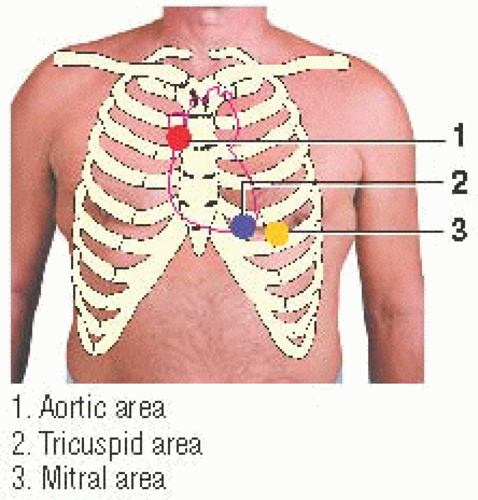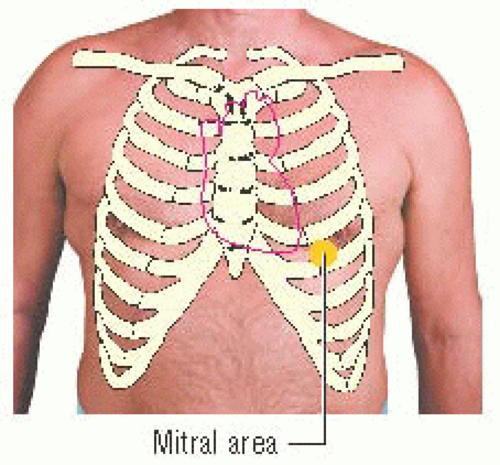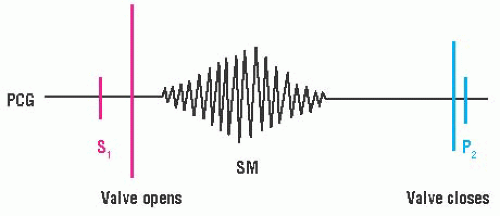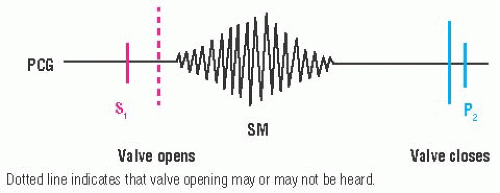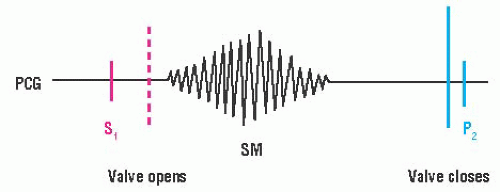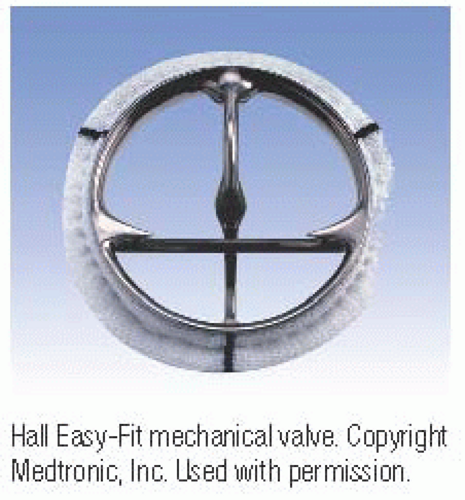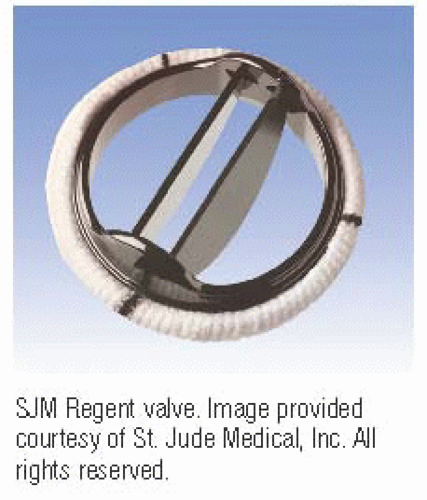Other Auscultatory Sounds
1. What are the four types of prosthetic valves?
2. What are the similarities and differences of the sounds produced by the four types of aortic prosthetic valves?
3. What are the similarities and differences of the sounds produced by the four types of mitral prosthetic valves?
4. What produces a pericardial friction rub?
5. What is mediastinal crunch?
PROSTHETIC VALVE SOUNDS AND MURMURS
Prosthetic heart valves—such as the ball-in-cage, tilting-disk, bileaflet, and porcine valves—are used to replace malfunctioning human valves. The aortic and mitral valves are the ones most commonly replaced. The tricuspid valve is replaced occasionally; the pulmonic valve, rarely. The following discussion focuses on the aortic and mitral valves.
Because mechanical valves last a long time, they’re usually inserted in children and adults younger than age 40. However, these valves shouldn’t be inserted in women of childbearing age because mechanical valve implantation requires the patient to take an oral anticoagulant, such as warfarin, which can cause birth defects if taken during the first trimester of pregnancy.
General characteristics
When a prosthetic valve is surgically placed in the aortic orifice, it’s positioned so that it opens during systole and closes at the beginning of diastole. However, when a prosthetic valve is surgically placed in the mitral orifice, it’s positioned so that it closes at the beginning of systole and opens during diastole.
An aortic prosthetic valve won’t change a normal first heart sound (S1), and a mitral prosthetic valve will not change a
normal second heart sound (S2). However, prosthetic valves do produce characteristic auscultatory sounds and murmurs. For example, some prostheses produce opening clicks, and all prostheses, regardless of type or position, produce closing clicks. The ball-in-cage valve produces the loudest sounds.
normal second heart sound (S2). However, prosthetic valves do produce characteristic auscultatory sounds and murmurs. For example, some prostheses produce opening clicks, and all prostheses, regardless of type or position, produce closing clicks. The ball-in-cage valve produces the loudest sounds.
Typically, any disappearance or muffling of previously heard prosthetic valve sounds or murmurs, or the development of a new murmur in a patient with a prosthetic valve, indicates possible prosthetic valve dysfunction.
Almost all prosthetic valves in the aortic position are associated with a soft early systolic or midsystolic ejection murmur. This murmur is heard best over the tricuspid, mitral, and aortic areas and is similar to the mild aortic stenosis murmur.
Some prosthetic valves in the mitral position produce a short, soft, rumbling early diastolic murmur, which is very similar to the mitral stenosis murmur except that it’s brief and a presystolic component isn’t heard. This murmur is heard best near the heart’s apex over the mitral area while the patient is in the partial left lateral recumbent position.
AORTIC PROSTHETIC VALVES
Distinctive sounds and murmurs are associated with the various types of prostheses used in aortic valve replacement. (♦Sound 47)
Aortic ball-in-cage valve
A normally functioning aortic ball-in-cage valve prosthesis doesn’t change the normal S1 characteristics. S1 is followed by an aortic opening click that’s louder than S1; it’s sharp and high-pitched, and it has a crisp quality. An aortic closing click replaces A2. Although the aortic ball-in-cage valve prosthesis is no longer inserted, patients with this type of prosthesis may still be seen.
Sound characteristics
The murmur generated by an aortic ball-in-cage valve prosthesis is usually heard best near the apex over the mitral and aortic areas and along the left sternal border. Its intensity is usually loud and easy to hear, and its duration variable. It has a medium pitch that’s heard best using the diaphragm of the stethoscope. The murmur has a crunchy, harsh quality. Its timing is midsystolic. The interval between the aortic closing click and P2 is similar to the normal A2-P2 interval, and it normally widens during inspiration. The murmur has a crescendo-decrescendo configuration.
Detecting a malfunctioning aortic ball-in-cage valve
Dysfunction of an aortic ball-in-cage valve prosthesis commonly causes the aortic opening click to become soft or absent; the aortic closing click may also be absent. A diastolic murmur and a long systolic ejection murmur (SEM) may appear.
Aortic tilting-disk valve
S1 is unchanged with abnormally functioning aortic tilting-disk valve prosthesis. An aortic opening click may be heard, and the interval between the aortic closing click and P2 is normal. The aortic closing click isn’t as loud as the click heard with a ball-in-cage prosthesis.
Sound characteristics
The murmur generated by an aortic tilting-disk valve prosthesis is usually heard best near the apex over the mitral and aortic areas and along the left sternal border. Its intensity is usually soft (grade) and its duration short. It has a medium pitch heard best with the diaphragm of the stethoscope. The murmur has a rough or harsh quality. Its timing is systolic. The interval between the aortic closing click and P2 is similar to the normal A2-P2 interval, and it widens during inspiration. The murmur has a crescendo-decrescendo configuration.
Detecting a malfunctioning aortic tilting-disk valve
Dysfunction of an aortic tilting-disk valve prosthesis commonly causes some or all of the following changes: the aortic closing click may be absent, a diastolic murmur may be heard, or a longer SEM may appear.
Aortic bileaflet valve
S1 is normal with a normally functioning aortic bileaflet valve prosthesis. The aortic opening click is commonly inaudible, but the closing click is loud and distinct.
Sound characteristics
Stay updated, free articles. Join our Telegram channel

Full access? Get Clinical Tree




